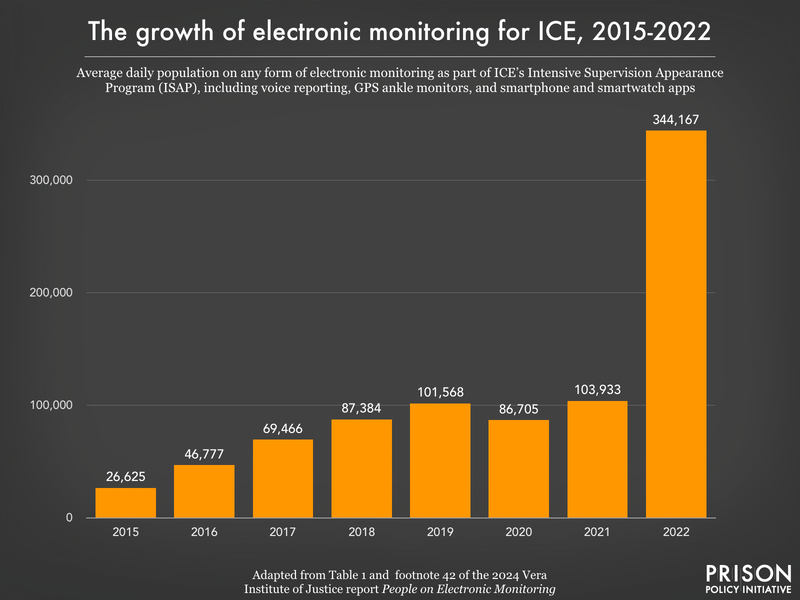This article was originally published by Prison Policy Initiative as “Watching the Watchers: Vera releases national census on electronic monitoring,” authored by Emmett Sanders.
In their new report, People on Electronic Monitoring, the Vera Institute of Justice completes a massive undertaking. Collecting data from all 50 states, more than 800 counties, and the federal court and immigration systems, this report offers the most comprehensive picture of the U.S.’s electronic monitoring population to date. Ultimately, their findings provide concrete evidence to support what activists and impacted people have long argued: Electronic Monitoring (EM) is not an effective way to reduce reliance on incarceration but is “often a crucial component of highly punitive, deeply entrenched criminal legal systems.” In other words, Electronic Monitoring is a form of incarceration, not an alternative to incarceration.
Vera’s data collection reveals that EM usage has increased significantly in all sectors since 2005, culminating in more than half a million adults under surveillance nationwide by either the criminal legal system or the immigration system.

EM usage in the criminal legal system is up significantly, with more than 150,000 people on EM at any given time in state and local monitoring systems. At the state and local level, EM is most heavily used in the Midwest, at a rate of 65 per 100,000 residents, more than a third higher than in the South, the next highest region of use, where it is used at a rate of 41 per 100,000 people. However, every region across the country has seen an increase in EM usage.
Immigration accounts for roughly two-thirds of the total EM population, with around 360,000 people monitored under ICE’s Intensive Supervision Appearance Program (ISAP). Much of this astounding increase occurred between 2021, when ICE monitored around 103,000 people, and 2022. This expansion is particularly concerning as ISAP’s EM conditions can be dehumanizing and physically and mentally taxing for people seeking asylum.

Overall, this increased usage has translated to big business for the 11 EM companies that control roughly 99% of the EM industry. Vera notes this translated to more than $1.2B spent on EM in 2023 alone. In many jurisdictions, EM programs are “primarily sustained by user fees,” which can range upward of $900 per month and shift the burden of funding to those least positioned to pay it – low-income individuals and families. As we have noted, however, this massive investment in digital incarceration has not replaced our reliance on more traditional “brick and mortar” incarceration in jails but rather serves as an expansion of overall state surveillance. Vera’s researchers note that an increase in EM usage can often accompany an increase in jail population, as in the case of Detroit, Michigan, which saw a 41 percent increase in EM use coincide with a 60% increase in jail population. Indeed, the report finds that “the majority of local jurisdictions with a high EM rate also had a high jail incarceration rate.”
While some EM expansion can be traced to COVID-19 pandemic response, Vera also notes that evolving technology is a large driver of increasing EM usage. The report points out that the use of GPS devices 1 increased thirtyfold between 2005 and 2021. Advancing technology has also increased the use of programs like cell phone apps to track and monitor people, which has impacted EM populations while raising new areas of concern, such as the potential for highly personal data to be shared and compromised.
Vera finds that other problems with EM usage include limited public accountability due to the “patchwork nature” of EM programs, which operate at multiple often tangled levels; this makes it difficult to track where public jurisdiction ends and private control begins, limiting programmatic accountability to the public and elected officials. Minimal oversight, heavy privatization, and lack of regulation also enable potential corruption, and some claim opens the door for abuses and extortion.
Ultimately, Vera finds that, though EM is touted as an alternative to incarceration, this massively expanding technology “acts as another form of incarceration, relies on technology rife with defects, shifts costs onto people with low incomes, and creates harm for directly impacted people and their loved ones.” We hope advocates can use Vera’s groundbreaking research to oppose the expansion of EM in their own communities.
Footnotes
- GPS monitoring devices use global positioning satellite technology to continually track and monitor movement. This is opposed to Radio Frequency devices which are generally connected to a centrally-based monitoring unit and send an alert when someone leaves its proximity. ↩
This article was originally published by Prison Policy Initiative as “Watching the Watchers: Vera releases national census on electronic monitoring,” authored by Emmett Sanders
